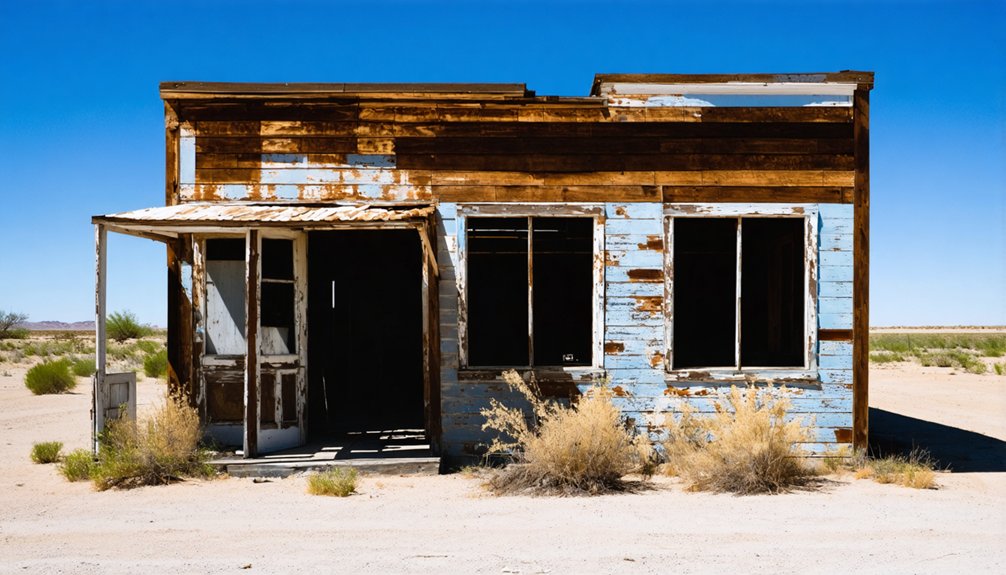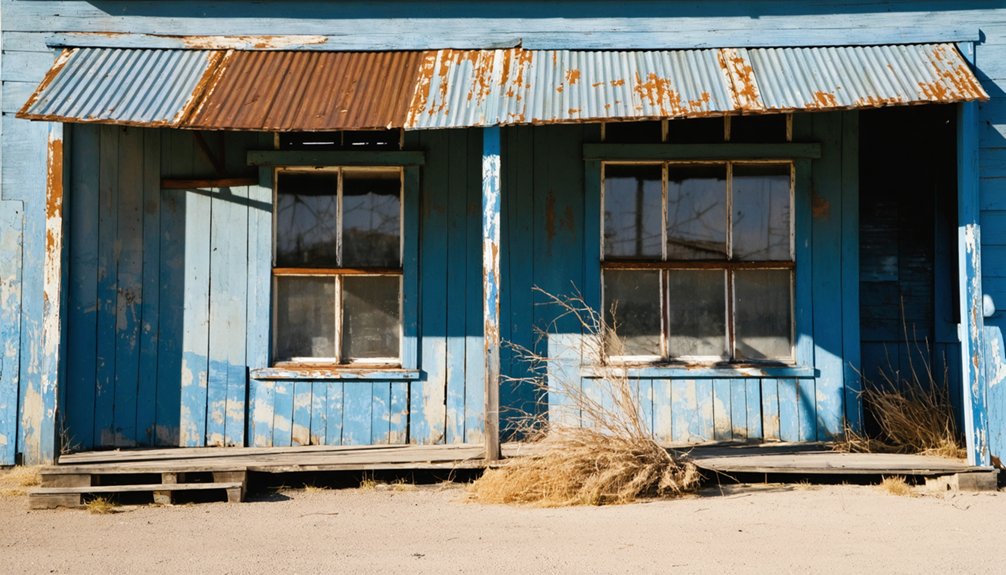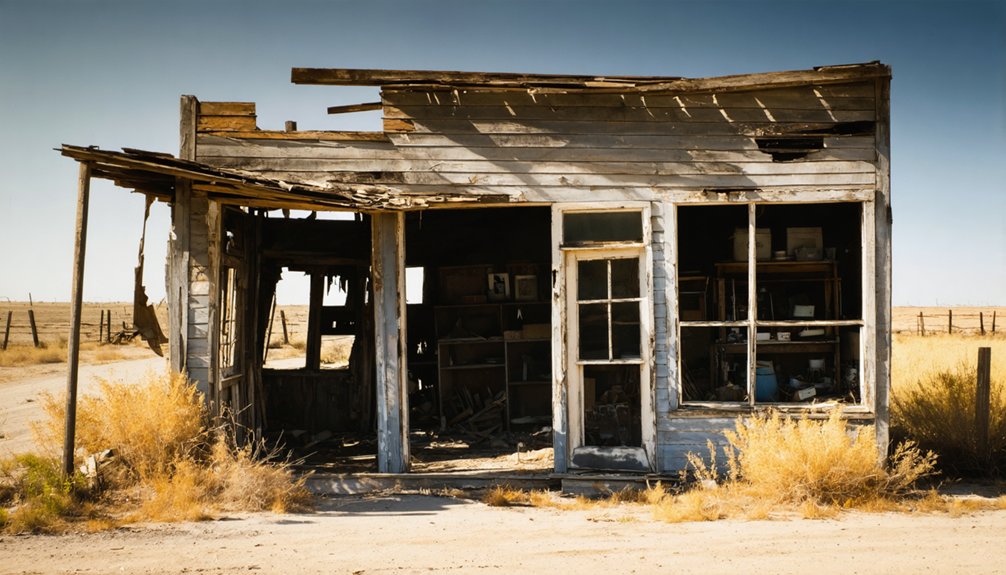You’ll find Sterley nestled in Robertson County’s Brazos River bottomlands, where Judge Robert Calvert’s 1850 land purchase sparked agricultural development. The settlement flourished through the 1920s with 176 farms at its peak, but faced devastating setbacks from disease outbreaks, Native American conflicts, and the Santa Fe Railway’s fateful bypass in 1867. Today, an eleven-acre cemetery and scattered ruins mark this ghost town‘s location, while local tales paint a complex picture of frontier life’s triumphs and tragedies.
Key Takeaways
- Sterley is an abandoned town in Robertson County, Texas, located 2 miles west of Calvert in the Brazos River bottomlands.
- The town thrived during the 1920s as an agricultural community, reaching its peak with 176 farms by 1925.
- Disease outbreaks, Indian raids, and the Santa Fe Railroad’s bypass contributed to Sterley’s eventual abandonment.
- The most significant remaining feature is an eleven-acre historic cemetery, with scattered building foundations throughout the area.
- Visitors must obtain permission to explore the site, as it’s now private property with no tourist facilities.
Location and Geography
The ghost town of Sterley lies in Robertson County in southeastern Texas, nestled within the fertile Brazos River bottomlands. You’ll find this abandoned settlement in a region where the river’s ecosystem influence has shaped both the landscape and its history.
The terrain features flat to gently rolling bottomlands typical of East Central Texas, with rich alluvial soils that once attracted settlers for agricultural pursuits. The area became particularly desirable after Judge Robert Calvert purchased the land in 1850. Much like Sterling City, which became a stop on Santa Fe during its growth period, Sterley’s development was influenced by transportation routes.
Settlers were drawn to East Central Texas’s fertile bottomlands, where gentle slopes and rich soils promised agricultural abundance.
Today’s land use reveals a dramatically different scene from its settled past. The area has largely reverted to its natural state, with minimal human alterations beyond the eleven-acre cemetery that serves as the primary remnant of Sterley’s existence.
Located east of present-day Calvert, the site exemplifies the dynamic between human settlement and natural reclamation in the Blackland Prairie transformation zone.
Early Settlement History
When Sterling Clack Robertson’s colony brought 600 families to Mexican Texas, he unknowingly set the stage for what would become the settlement of Sterling (later Sterley).
You’ll find the area’s true pioneer settlement began in 1836 with A.J. Webb’s land grant, followed by Judge Robert Calvert’s pivotal purchase in 1850. The fertile Brazos River bottomland influenced settlement patterns, though pioneer challenges were severe. Like Terlingua’s vanished residents, these early settlers left behind personal belongings that tell stories of their daily lives.
Early settlers faced devastating diseases, including the Yellow Fever epidemic of 1873, while enduring frequent raids from Comanche, Lipan Apache, and Kiowa tribes. Notable conflicts, like the Battle at Live Oak Mott and the “U” Ranch clash of 1879, marked the tumultuous relationship between settlers and native peoples. The establishment of Fort Concho in 1867 provided much-needed protection for the area’s growing ranching operations.
Despite these hardships, determined families established homes, ranches, and social institutions.
Peak Economic Years
You’ll find that Sterley’s peak economic years were deeply tied to agriculture rather than significant railroad development, with local commerce mainly serving farming and ranching operations through the 1920s.
The town’s trade activity centered on essential agricultural support services, as livestock numbers doubled between 1920-1930 and the number of farms briefly increased to 176 by 1925. Similar to how cinnabar deposits fueled mining economies elsewhere in Texas, Sterley’s natural resources shaped its development trajectory. Like many historical Texas towns, Sterley faced challenges when transportation routes shifted and economic patterns changed.
While other Texas towns boomed with rail connections, Sterley’s economy remained chiefly focused on serving local agricultural needs, with businesses supporting the area’s expanding cattle and sheep operations.
Railroad Industry Impact
Following extensive lobbying efforts that began in 1891, Sterling City’s economic fortunes dramatically shifted with Santa Fe Railway’s 1910 construction of a 42-mile branch line connecting San Angelo to Sterling City.
The railroad expansion transformed the region by following the North Concho River valley’s natural advantages, establishing essential transportation infrastructure that revolutionized the movement of goods and people. Similar to other Texas towns like Lockney, which saw track-laying commence with Santa Fe in 1910, the railway development marked a critical milestone for the area. The railroad celebrated its completion by offering free rides to San Angelo.
You’ll find evidence of this economic transformation in the county’s property valuations, which soared from $1,276,225 in 1903 to over $2 million by 1913.
The railway’s presence strengthened Sterling City’s ranching economy, providing efficient export channels for livestock.
While cotton agriculture initially flourished in the late 1880s, the railroad’s arrival cemented livestock ranching as the dominant industry, connecting local producers to broader national markets through Santa Fe’s extensive network.
Local Trade Development
The economic prosperity brought by the Santa Fe Railway sparked a vibrant period of local trade development in Sterling City during the 1910s and early 1920s.
You’ll find that the Brazos River bottom’s fertile land attracted numerous pioneering families, establishing essential trade routes along the river that connected Sterling to neighboring communities. Similar to Texas towns like Ghost Town Terlingua, Sterling relied heavily on natural resources and trade to sustain its economy. Many residents conducted hidden treasure hunts during off-seasons to supplement their farming income.
Local commerce flourished despite significant commerce challenges, including:
- Cotton production struggles due to the devastating boll weevil epidemic
- Competition from larger agricultural centers in the region
- Economic pressures from the looming Great Depression
- Disease outbreaks that disrupted trade patterns
The town’s strategic location along the Brazos River helped maintain its economic vitality through the 1920s, though external factors would eventually lead to its decline.
Judge Robert Calvert’s early land purchase in 1850 had laid the foundation for what would become a brief but notable trading hub.
Factors Leading to Decline
Multiple factors contributed to Sterling’s decline in the late 19th and early 20th centuries, with the Santa Fe Railroad‘s decision to bypass the settlement dealing the most devastating blow.
Without rail access, Sterling couldn’t compete with nearby towns that gained crucial transportation links, triggering severe economic decline and population migration.
The town’s challenges were compounded by broader shifts in agriculture and commerce. You’d have seen families gradually leaving as farming became less viable and urban opportunities beckoned elsewhere.
Disease outbreaks and Indian raids had already weakened the community’s foundation, making recovery from these economic setbacks nearly impossible.
The final nails in Sterling’s coffin came as it lost its institutional functions – its post office, schools, and local services – to railroad towns that could better serve the region’s needs.
Notable Structures and Ruins

Scattered across Sterley’s windswept landscape, remnants of the town’s mining heritage persist through a collection of deteriorating yet distinctive structures.
Time-worn mining structures stand as silent sentinels of Sterley’s past, slowly fading into the windswept Texas terrain.
You’ll find original mining equipment near weathered windmills, while adobe and stone buildings showcase frontier architectural features that have endured decades of harsh desert conditions.
Key structures you can explore include:
- The historic General Store building, one of the oldest remaining commercial structures
- A repurposed jail building now serving modern visitor needs
- The authentic boot hill cemetery, still active with both historic and recent graves
- Several mining company facilities, including the former company store
While many structures remain off-limits due to preservation efforts and safety concerns, you can still witness the rugged beauty of these historic ruins against the dramatic Texas desert backdrop.
Local Stories and Legends
Deep within Sterling’s history lie compelling stories of resilience and tragedy that shaped this Texas ghost town‘s identity.
Local folklore tells of deadly yellow fever outbreaks in 1873 that decimated the population, with haunting tales of families desperately hiding their children from the epidemic’s reach.
You’ll find stories of isolated hermits who braved rattlesnakes and harsh conditions, surviving off the land as the town declined around them.
The town’s fate took another turn through a legendary feud when a sheriff’s deputy killed a businessman’s son, leading to revenge through railroad politics.
The resulting “Big Curve” railroad bypass stands as evidence of this dark chapter, deliberately routing commerce away from Sterling and contributing to its ultimate downfall.
These stories endure through community preservation efforts and cultural events celebrating the town’s complex heritage.
Visiting the Ghost Town Today

While Sterling’s remains lie quietly 2 miles west of Calvert in Robertson County, accessing this historic ghost town requires careful planning and respect for private property boundaries.
Just beyond Calvert’s western edge, Sterling’s ghostly remnants beckon adventurous souls willing to navigate private lands with care.
The site’s main visitor tips focus on preparation and legal considerations before exploration.
Key exploration challenges you’ll encounter include:
- Limited infrastructure and signage, requiring local guidance
- Private property restrictions necessitating advance permission
- Overgrown terrain demanding appropriate footwear and supplies
- No tourist facilities or restrooms available on-site
You’ll find the eleven-acre historic cemetery serves as the most significant remaining feature, along with scattered foundations and a historical marker.
While photographing these remnants, you’ll appreciate why the town declined after the railroad’s 1867 bypass, which ultimately led to Sterling’s abandonment in favor of nearby settlements.
Frequently Asked Questions
Were Any Notable Outlaws or Gunfights Associated With Sterley?
You won’t find outlaw legends or gunfight tales from Sterley. While other Texas towns earned reputations for violence and notorious criminals, research shows no documented shootouts or outlaws connected to this location.
What Happened to the Original Cemetery and Are There Marked Graves?
You’ll find the original 11-acre cemetery still stands as a historic monument. While specific cemetery restoration efforts aren’t documented, surviving grave markings likely represent Sterling’s pioneer families and early settlers.
Did Any Significant Natural Disasters Contribute to Sterley’s Abandonment?
You won’t find evidence of natural disasters causing Sterley’s abandonment. Historical records suggest economic decline and changing transportation patterns were the primary factors that led to the town’s gradual disappearance.
What Native American Tribes Originally Inhabited the Sterley Area?
You’ll find that Comanches, Lipans, Kiowas, and Kickapoos shaped the cultural heritage of this region, maintaining their tribal traditions through hunting, trading, and establishing complex alliances across these vast plains.
Are There Any Preservation Efforts or Historical Markers for Sterley?
You won’t find official historical markers or preservation initiatives in Sterley today. While the town holds historical significance to the region’s development, no formal conservation efforts currently protect its remaining traces.
References
- https://www.youtube.com/watch?v=UniG4FbRwaw
- https://www.youtube.com/watch?v=phjUE19A8HM
- https://www.southernthing.com/ruins-in-texas-2640914879.html
- https://texashighways.com/travel-news/four-texas-ghost-towns/
- https://www.ghostsandgetaways.com/ghost-towns
- https://en.wikipedia.org/wiki/List_of_ghost_towns_in_Texas
- https://ghosttowntexas.com
- https://authentictexas.com/texas-ghost-towns/
- https://www.navasotaexaminer.com/article/columns/sterling-texas-ghost-town
- https://texastimetravel.com/cities/sterling-city/



